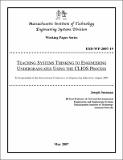| dc.description.abstract | The introductory science courses taken by engineering undergraduates are usually intensely reductionist in form, silos in physics, chemistry, biology, and so forth. Then, their engineering subjects in the early undergraduate years often tend to be reductionist as well, focusing on a fairly narrow view of the engineering issues practitioners face. Even the design classes often do not account for the socio-technical context for much of the engineering design space that involves a complex interaction between various technologies and the multiple stakeholder views.
This paper describes a subject called Engineering System Design, which attempts to create a broader perspective for third-year students in engineering—and indeed in related disciplines in management and planning. It is a combination of lectures on methods related to systems thinking and a semester-long class-wide complex socio-technical system design utilizing these methods and concepts. In recent years, the case has focused on the transportation of spent nuclear fuel to Yucca Mountain, Nevada and related issues in global climate change.
Experiences in teaching this class will be discussed and some techniques adopted to enable learning are presented. | en_US |
